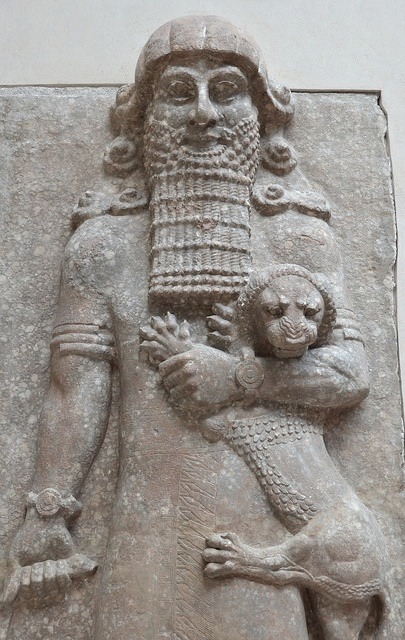Essays
Required Reading: The Hero With a Thousand Faces

by Karen Newcombe
This year marks the 65th since the first publication of Joseph Campbell's great masterpiece, The Hero With a Thousand Faces.
It has been at least ten years since I've read Hero, perhaps longer, but the value of this marvel has not diminished one bit.
Every writer should spend the time needed to read and digest this book thoroughly, because every story you ever write will be enriched by what you learn here.
Campbell's life work was to study the mythologies and religions of all cultures and seek the common threads that lend meaning to civilization on the grand scale, and individual lives at the human level. His body of work is vast and I don't intend to delve into it here. I simply want to discuss what I find valuable as a writer in this one book.
The main points of Hero are that every worthwhile story contains some or all elements of the great myth. Campbell identified a roster of common elements among the world's mythologies, and speaks of them as the monomyth – the great human mythology that is present in every culture.
In this cycle, the hero (or heroine) is called to adventure, sometimes by a mystical means, sometimes simply by chance. The hero may reject the call, but it will continue to make itself felt until there is no choice but to accept the challenge. The hero passes out of his normal life and sets out on a journey. Along the way he is aided by mystical beings and challenged by monsters, elements, gods, and enemies. Ultimately he must plunge into the deepest, darkest and most desperate place, there to either triumph or fail. Sometimes he or she actually dies, and must be brought back to life.
Once the hero survives and triumphs, he must now find a way to return to the normal world, bringing back his gifts of knowledge and whatever boons the gods have granted to him in the service of his people. The journey does not end when the battle is won, it ends when the hero arrives safely home, puts the baby on his knee, and says "Well, I'm back." Returning to life and service can be just as important as the battle.
Campbell makes an excellent case for this story cycle being a reflection of the deep spiritual challenge faced by every person during their lifetime: each of us must survive through the dangers of growing up, the departure from the family, the sacred mystery of love, the confrontation with our own mortality, and for some, a great spiritual struggle that may lead to enlightenment and awareness of our higher nature.
While every story does not contain all of these elements, every story does contain at least one, and often many of them.
We find good stories deeply satisfying because they contain these resonant elements, which are profoundly rooted in the human psyche. Campbell speaks often in Hero about psychoanalysis and dream analysis. These were at the forefront of psychological science in the 1940s, but some of these passages in Hero now seem dated and quaint. We have much more knowledge about psychology and the biochemical operations of the brain at our disposal today. Yet Campbell's references to the early forms of psychology do not diminish the power contained in the elements of the Hero's Journey, or its relevance to both personal experience and the writer's craft.
Reading a summary of Hero is no substitute for reading the book yourself. Campbell's examples are drawn from the mythologies, fairy tales and religions of the world, and offer clear, powerful illustrations of how the elements of the monomyth play out. Understanding why these stories continue to resonate with us across the centuries, or even millennia, can help any writer bring more powerful energies into his own work.
For some writers a wider study of Campbell's many works on mythology will offer a host of ideas for story and story elements. A thorough understanding of mythology and folk tale helps the writer add depth – or even humor – to his work.
Guides to the Hero's Journey as a Plot Structure
There are dozens of guides and charts to help writers make practical use of the Hero's Journey to create plot lines. Former Disney story consultant Christopher Vogler was certainly one of the first to put a succinct summary together for writers, available here: http://www.thewritersjourney.com/hero's_journey.htm
Vogler makes a point worth mentioning: adhering strictly to the full plot format may be too obvious to readers, with the structure showing through plainly instead of flowing naturally within the story. Writers should choose the elements that will best serve their current purpose, not try to force the story to fit an outside structure.
That said, Vogler also says that "The myth can be used to tell the simplest comic book story or the most sophisticated drama. It grows and matures as new experiments are tried within its basic framework. Changing the sex and ages of the basic characters only makes it more interesting and allows for ever more complex webs of understanding to be spun among them. The essential characters can be combined or divided into several figures to show different aspects of the same idea. The myth is infinitely flexible, capable of endless variation without sacrificing any of its magic, and it will outlive us all."
Further: For a brain electrifying dose of Campbell's compelling lectures, I highly recommend getting your hands on the DVD set of The Power of Myth, the video interviews with Campbell by Bill Moyers held at Skywalker Ranch in the 1980s.
Photo credit: Prof. Mortel / Foter / CC BY-NC-SA 2.0
